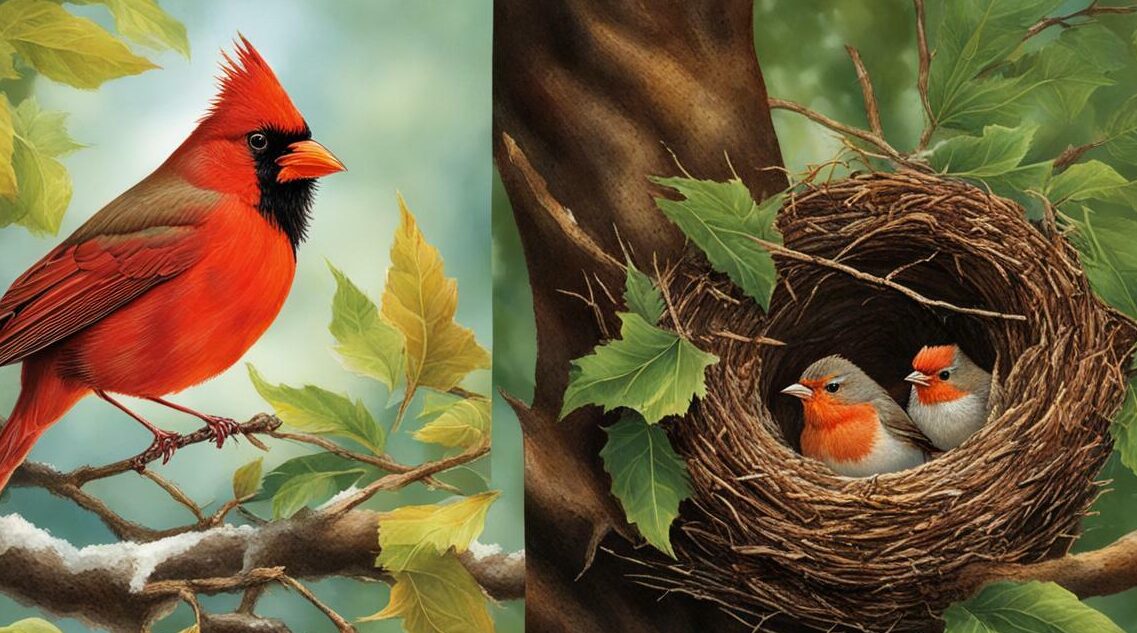As a bird watcher, understanding nesting habits is critical to observing and conserving these beautiful creatures. Cardinals and robins are two of the most common birds found in North America. In this article, we will compare their nesting habits and behaviors to help you learn more about these popular species.
Key Takeaways:
- Comparing the nesting habits of cardinals and robins can provide insight into their behaviors and preferences.
- Understanding bird nesting habits is essential for bird watchers and conservation efforts.
- Observing nesting habits in the wild requires respectful and non-intrusive practices.
Understanding Cardinal Nesting Habits
Cardinals are well-known for their vibrant red plumage, but their nesting habits are just as fascinating. Understanding these habits can provide valuable insights into their behavior and preferences.
| Preferred Nest Locations | Cardinals typically prefer to build their nests in dense shrubs or vines, often near the edges of wooded areas. They may also choose to nest in low trees or bushes. |
|---|---|
| Materials Used | Cardinals use a variety of materials to construct their nests, including twigs, grasses, bark, and leaves. They may also use softer materials like feathers, rootlets, and animal hair to line the nest. |
| Nesting Strategies | Cardinals are monogamous birds and typically mate for life. Both male and female cardinals work together to build the nest, with the male bringing materials and the female doing most of the construction. Once the nest is built, the female lays 3-4 eggs which hatch after an incubation period of around 12 days. The male assists with feeding the chicks and both parents continue to care for them until they fledge, which usually takes around 10-11 days. |
By understanding the nesting preferences and strategies of cardinals, bird watchers can better appreciate these beautiful birds and their unique behaviors.
Exploring Robin Nesting Behaviors
Robins are known for their distinct nesting preferences and behaviors. They typically build their nests in shrubs, trees, or on man-made structures like window sills or porch ledges. Robin nests are made of grasses, twigs, and other plant materials, and are often reinforced with mud to create a sturdy structure.
Unlike cardinals, robins are not territorial during the nesting season and may even build their nests in close proximity to one another. Once their nests are built, robins use various strategies to protect their eggs and offspring from predators. For example, they have been observed dive-bombing potential threats like snakes or cats.
Robins also have a unique approach to feeding their young. They feed their chicks a diet of earthworms, insects, and berries, which they gather from nearby areas. They generally make multiple feeding trips each hour during the daylight hours.
Overall, understanding the nesting habits of robins is crucial for bird watchers and conservationists alike. By observing their behaviors and taking steps to protect their nesting sites, we can help ensure the survival of this beloved bird species.
Similarities in Nesting Habits
While cardinals and robins have some differences in their nesting habits, they also share some common strategies and behaviors.
For example, both birds tend to build their nests using soft materials such as grasses, twigs, and leaves. They also both use mud to reinforce their nests and keep them sturdy.
Additionally, both cardinals and robins have a similar incubation period of approximately two weeks. During this time, they take turns sitting on the eggs to keep them warm and ensure proper development.
Once the eggs hatch, both birds provide attentive parental care to their young. They feed the chicks frequently and protect them from predators.
Overall, the similarities in nesting habits between cardinals and robins illustrate the evolutionary strategies that have optimized these behaviors for successful reproduction and survival.
Differences in Nesting Habits
While cardinals and robins both build nests to raise their young, there are notable differences in their nesting habits. Cardinals tend to build their nests in dense shrubs and trees, while robins prefer to nest in open areas such as on branches or ledges.
Another difference is in their preference for nesting materials. Cardinals often use twigs, bark strips, and grasses to construct their nests, while robins prefer mud and grasses.
When it comes to incubation periods, cardinals and robins differ as well. Cardinals typically take 11 to 13 days to incubate their eggs, while robins may take up to 14 days.
Parental care also varies between the two species. While both male and female cardinals share parental duties, robins typically have the female doing most of the incubating and brooding, while the male provides food for the family.
Understanding these differences in nesting habits is crucial for bird watchers and conservationists alike. By observing and documenting these behaviors, we can better protect the habitats and populations of these beautiful birds.
Factors Influencing Nesting Habits
The nesting habits of cardinals and robins are influenced by a variety of factors, including habitat, climate, and predator presence. Understanding these factors can help bird watchers predict and observe nesting behaviors.
Cardinal nesting habits: Cardinals are known for their preference for nesting in dense shrubs and bushes, often near a reliable food source. They typically build their nests using grasses, twigs, and leaves, and may even incorporate man-made materials such as string or fabric. Cardinals also tend to nest low to the ground, which may help protect their nests from strong winds and adverse weather conditions.
Robin nesting habits: Robins are more likely to build their nests in open areas, such as fields or lawns. They prefer to build their nests using mud, grasses, and other soft materials. Robins typically nest in trees or on man-made structures such as buildings or porch ledges. They are also known for their unique strategy of building a mud cup inside their nests to protect their eggs and nestlings from predators.
Both cardinals and robins may change their nesting habits in response to changes in their environment. For example, if a predator is present in the area, they may choose a higher or more protected nesting location. Similarly, if their preferred nesting materials are not available, they may use alternative materials.
By understanding the factors that influence nesting habits, bird watchers can better predict where and when cardinals and robins might build their nests. This knowledge can also be used to inform conservation efforts and promote habitats that support healthy bird populations.
Observing Nesting Habits in the Wild
Observing bird nesting habits can be an exciting and educational experience for bird watchers. However, it is important to be respectful of the birds and their environments while doing so. Here are some tips for observing nesting behaviors in the wild:
Choose the Right Time and Place
Early morning or late afternoon is an ideal time to observe nesting habits, as birds are often more active during these times. It is also important to choose a location that provides a clear view of the nest but does not disturb the birds or their habitat. Using binoculars or a spotting scope can be helpful in getting a closer look without getting too close!
Observe Quietly and Patiently
When observing nesting behavior, it is important to remain quiet and still. Sudden movements or loud noises can startle birds and cause them to abandon their nests. Patience is key, as birds may take breaks from incubating or feeding their young, and you may need to wait for them to return.
Record Observations Carefully
Keeping track of your observations can help you better understand bird nesting habits. It is important to record the date, time, location, and behavior observed. Avoid disturbance by recording away from the nest and never touch or handle eggs or young birds.
Respect Boundaries and Wildlife
It is important to respect boundaries and laws relating to protected areas and wildlife. Do not disturb nests or birds, and keep a safe distance. Remember, observing nesting habits should be done with the goal of learning and appreciating the birds and their natural behaviors.
Observing bird nesting habits can be a rewarding experience for bird watchers, providing a glimpse into the fascinating world of birds. By following these tips and respecting the birds and their environments, you can gather valuable information while helping to preserve and protect these important habitats.
Conclusion
Understanding the nesting habits of birds like cardinals and robins is crucial for bird watchers and enthusiasts who want to observe and appreciate these beautiful creatures in their natural habitats. Through this article, we have explored the nesting habits of cardinals and robins, comparing and contrasting their behaviors, and understanding their unique strategies for protecting their nests and offspring.
While there are similarities between the two species in terms of nest structures, incubation periods, and parental care, there are also significant differences in their nesting locations, materials used, and nesting strategies. These differences are influenced by various factors such as habitats, climates, and predator presence.
By observing bird nesting behaviors in the wild, we can gain valuable insights into these fascinating creatures, their habits, and lifestyles. It is, however, important to do so respectfully and record observations in a responsible manner.
 Skip to main content
Skip to main content


